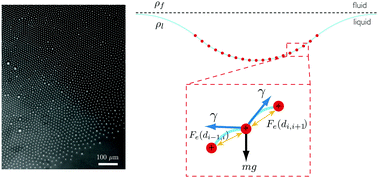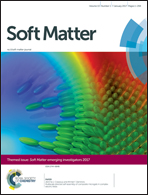Self-assembly of repulsive interfacial particles via collective sinking
Abstract
Charged colloidal particles trapped at an air–water interface are well known to form an ordered crystal, stabilized by a long ranged repulsion; the details of this repulsion remain something of a mystery, but all experiments performed to date have confirmed a dipolar-repulsion, at least at dilute concentrations. More complex arrangements are often observed, especially at higher concentration, and these seem to be incompatible with a purely repulsive potential. In addition to electrostatic repulsion, interfacial particles may also interact via deformation of the surface: so-called capillary effects. Pair-wise capillary interactions are well understood, and are known to be too small (for these colloidal particles) to overcome thermal effects. Here we show that collective effects may significantly modify the simple pair-wise interactions and become important at higher density, though we remain well below close packing throughout. In particular, we show that the interaction of many interfacial particles can cause much larger interfacial deformations than do isolated particles, and show that the energy of interaction per particle due to this “collective sinking” grows as the number of interacting particles grows. Though some of the parameters in our simple model are unknown, the scaling behaviour is entirely consistent with experimental data, strongly indicating that estimating interaction energy based solely on pair-wise potentials may be too simplistic for surface particle layers.

- This article is part of the themed collection: Soft Matter Emerging Investigators

 Please wait while we load your content...
Please wait while we load your content...